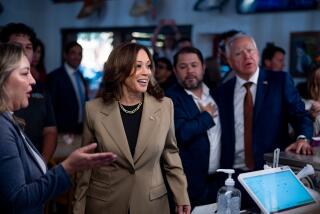I’ll have the free-range Jell-O
- Share via
A year after Nancy Pelosi (D-Calif.) became speaker of the House, the legislative landscape has not changed all that much because many of her most ambitious goals -- winding down the war in Iraq and rolling back key provisions of President Bush’s tax cuts -- have not been met. But there’s definitely a new landscape in the only part of the Capitol where Pelosi can exert her will entirely untrammeled: the cafeteria in the basement of the House’s Longworth Office Building on the south side of the Hill.
“Greening the Capitol” is one of Pelosi’s pet projects, and the Longworth cafeteria is the carbon-neutral jewel in her crown. The cafeteria, which primarily caters to House employees but is also open to the general public, ditched its old food contractor and reopened after the holiday recess with a new menu that punches every available slot on the eco-friendly ticket favored by food trendies: “organic” (as in fertilizers and pesticide-free), “sustainable” (as in farming techniques), “rBGH-free” (as in milk), “cage-free” (as in chickens), “fair-traded” (as in grown by co-ops in the Third World), “local” (as in grown within a 150-mile radius in the First World) and, where possible, combinations of two or more of the above. Oh, and no trans fats -- this cafeteria food is good for you too.
In the old days, the House cafeteria, like its Senate counterpart in the basement of the Dirksen Office Building on the north side of the Hill (also open to the public except during the lunch rush), offered the usual cafeteria fare: meatloaf, burgers, chili, giant slabs of coconut cake with mountains of whipped bad cholesterol on top. You can still get a burger in the Longworth cafeteria -- but it’s made from “humanely raised, antibiotic-free beef.” You can still get chili too -- if you prefer “roasted corn and poblano chili” to the old-fashioned meat-and-beans variety.
There’s more on the new menu. Instead of a classic BLT, you can order a “PLT” -- that’s a portabello, lettuce and tomato sandwich. For $6.75, you can get panzanella salad, which, for the uninitiated, is the new Caesar salad -- more or less the same thing but with bigger croutons. The coffee comes from a Costa Rican outfit, called Pura Vida, that embodies a trifecta of environmental and other correctness. It’s organic, it’s fair-traded and it’s “shade-grown,” which means grown in jungle-like conditions that harbor migratory birds whose habitats are threatened by deforestation elsewhere.
What you can’t get are large portions of the high-calorie, high-energy comfort foods favored by many of the workers who man the security stations and mind the vast physical infrastructure at the House. When I worked at the Library of Congress, the top lunch choice of security guards was fried chicken. “Green” food is food for desk jockeys with picky appetites.
As green as the food in the House cafeteria is the decor -- that sickly shade of pastel avocado much favored by today’s interior decorators -- as well as the trays, plates, cups, straws and other implements. Most of the latter are made of such “biocompostable” materials as cornstarch and are manufactured by a nonprofit organization called World Centric, whose larger aim is to “reduce economic injustice and environmental degradation.” World Centric knives, forks and teaspoons -- there are no soup spoons -- are rickety objects with dull serrations on the knives (perhaps reflecting the Democrats’ stance on the right to bear arms).
Even stranger are the paper napkins, dispensed from containers that allow you just one apiece: thin, scratchy quadrangles that resemble nothing so much as the “one square” that singer Sheryl Crow said we ought to use in the loo to fight global warming. She subsequently claimed that she had been joking.
Numerous recycling stations on the cafeteria’s perimeter provide instructions as to which of four separate slots of different sizes disposable items should be placed in. Coffee cups go into the “compostable” slot, coffee lids into the “landfill” slot -- or is it the other way around? I couldn’t help but observe during a recent lunchtime visit that most Longworth visitors ignored the recycling rules and just dumped all their trash into the biggest slot they could find -- the compostable slot. Good luck composting that Coke cap.
It was a relief, then, to trudge up the Hill to the Dirksen building, where, give or take a few updates (sushi, for example), it was cafeteria business as usual: mac and cheese, double burgers (undoubtedly from inhumanely raised cows), unfairly traded Starbucks coffee, Cheetos-dispensing vending machines and those shredded carrots amid the lettuce at the salad bar that demarcate the socioeconomic line between the food proles and the foodies. Not to mention real stainless-steel flatware and real china plates. Perhaps that’s because Senate Majority Leader Harry Reid (D-Nev.) is not into “greening,” or perhaps it’s because certain Senate dishes -- such as the famous navy bean soup, on the menu since 1903 -- are simply iconic. Dated though the Senate fare might be, the lunch-hour traffic was as dense in Dirksen as it was in Longworth.
There are many metonymic lessons that one might draw from surveying the over-the-top amalgam of sometimes conflicting food fads -- it’s hard to do “fair trade” and “local” at the same time -- present in Pelosi’s cafeteria remake. For example, what the Democratic Party once was (the party of ordinary people) compared to what it is now (the party of the elite and the trendy).
The more telling lesson might be how easy it is to feel virtuous -- whether about the environment or your health or the Third World -- by simply painting the lunchroom green, eating with a cornstarch fork and making a few other culinary gestures.
More to Read
Eat your way across L.A.
Get our weekly Tasting Notes newsletter for reviews, news and more.
You may occasionally receive promotional content from the Los Angeles Times.










